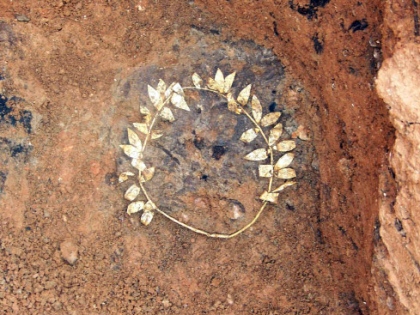
Golden garlands and the golden coins treasure, which was carried out of the Rhodes Island port, were found in Thessaloniki. Elefterios Tipos newspaper makes a ranking, in which this treasure is one of the most important developments of last year. In the year when the most famous archeologist Indiana Jones came back to the big screen with crystal skulls, the real archeology had something to be proud of too.
Golden Macedonian garlands
The excavations in Thessaloniki are still going on and they are winning all area records for one archeological site – 20 000 square meters. More than 1400 graves from the Hellenic era, from Roman times and from the early Christianity were found in the city while digging for the new metro. In them, jewelry was found, coins, containers, but the most extraordinary findings are the golden garlands from the Hellenic era. The four olive leafs and one acorn leaf garlands impressed the scientist and their pictures circled around the world.
The Palace in Vergina
Archeologist Angeliki Kotaridi unraveled the secrets of the Vergina castle. She found out that the palace was built in the period between 350-340 BC during the rule of Philip II, father of Alexander the Great. The archeologist claims that the architect of the palace was Petei, who also created the plans for the famous mausoleum in Halikarnas. The scientist made another very important discovery – they calculated the exact step, which was a measuring unit for the Macedonians and they managed to create a 3D image of the palace.
Rhodes Island Treasure
In the spring of 2008, 4000 golden coins and ornaments were found on Rhodes Island trade port. Most of them are ottoman and made during the 18th century. According to archeologists form the underwater archeology service “the finding is very rare, because the coins are from different editions and are made from very expensive material.” This type of Ottoman coins were cut out for the first time during 1477 from Mohamed the second. A local citizen helped the archeologists to find the underwater location of the coins and also said that many ships crashed in the area.
Roman sculptures in the sea of Kitnos